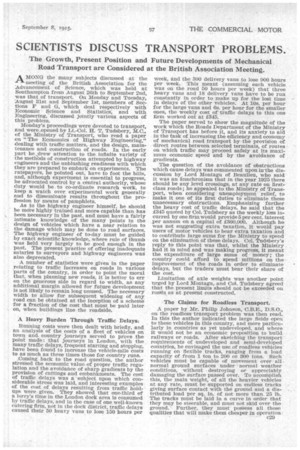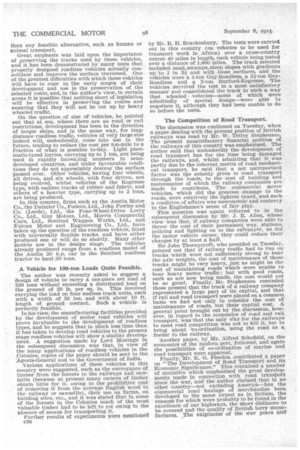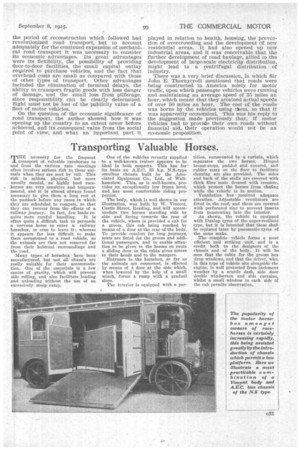SCIENTISTS DISCUSS TRANSPORT PROBLEMS.
Page 13

Page 14

Page 15

If you've noticed an error in this article please click here to report it so we can fix it.
The Growth, Present Position and Future Developments of Mechanical Road Transport are Considered at the British Association Meeting.
A MONG the many subjects discussed at the meeting of the British Association for the 'Advancement of Science, which was held at Southampton from August 26th to September 2nd, was that of transport. On Monday and Tuesday, August 31st and September 1st, members of Sections F and G, which deal respectively with Economic Science and Statistics, and with Engineering, discussed jointly various aspects of this problem.
Monday's proceedings were devoted to transport, and were.opened by Lt.-Col. H. T. Tudsbery, M.C., of the Ministry of Transport, who read a paper on "The Economics of Highway Engineering," dealing with traffic matters, and the design, maintenance and construction of roads. In the early part he ,drew attention to the infinite variety of the methods of construction attempted by highway engineers and the unblushing readiness with which they are prepared to embark on experiments. The ratepayers, he pointed out, have to foot the bills, and, although experiment is essential to progress, he advocated control by a central authority, whose duty would be to co-ordinate research work, to keep a watch over experimental work generally and to disseminate results throughout the profession by means of pamphlets.
As to the highway engineer himself, he should be more highly trained and more capable than has k. been necessary in the past, and must have a fairly intimate knowledge of the many points in the design of vehicles which have a near relation to the damage which may be done to road surfaces. The highway engineer of to-day must be guided by exact scientific knowledge, where rule of thumb was held very largely to be good enough in the past. The present practice of offering inadequate salaries to surveyors and highway engineers was also deprecated.
A number of statistics were given in the paper relating to traffic increases on roads in various parts of the country, in order to point the moral that, when planning new roads, it is better to err on the generous side in regard to width, as any additional margin allowed for future development is not likely to remain long unused. The necessary width to allow for subsequent widening of any road can be obtained at the inception of a scheme for a fraction of the cost that must be paid later on, when buildings line the roadside.
A Heavy Burden Through Traffic Delays;
Running costs were then dealt with briefly, and an analysis of the costs of a fleet of vehicles on town and. country journeys served to prove the point made : that journeys in London, with the many traffic delays, frequent starting and stopping, have been found to increase the vehicle-mile costs to as much as three times those for country runs. Coming back to the road question, the author stressed the economic value of proper traffic regulation and the avoidance of sharp gradients by the provision of cuttings and embankments. The cost of traffic delays was a subject upon which considerable stress was laid, and interesting examples of the cost of delays resulting from traffic holdups were given. They showed that one-third of a lorry's time in the London dock area is consumed hy traffic delays, and in the case of one well-known catering firm, not in the dock district, traffic delays caused their 50 heavy vans to lose 150 hours per week, and the 300 delivery vans to lose 900 hours per week. This meant (assuming each vehicle was on the road 50 hours per week) that three heavy vans and 18 delivery vans have to be run constantly in order to make up for the lost time in delays of the other vehicles. At 10s. per hour for the large vans and Os. per hour for the smaller ones, the weekly cost of-traffic delays to this one firm worked out at £345.
The paper served to show the magnitude of the work which the Roads Department of the Ministry of Transport has before it, and its anxiety to aid in the task of increasing the efficiency and economy of mechanical road transport by. the provision of direct routes between selected terminals, of routes on which traffic may proceed safely at its maximum economic speed and by the avoidance of gradients.
The question of the avoidance of obstructions which cause delays was commented upon bathe discussion by Lord Montagu of Beaulieu, who said it was an anachronism that in the year 1925 there should be any level crossings, at any rate on `firstclass roads ; he appealed to the Ministry of Transport, when considering unemployment relief, to make it one of its first duties to eliminate these unnecessary obstructions. Emphasizing further the heavy cost of traffic delays, he said that the 1345 quoted by Col. Tudsbery as the weekly loss incurred by one firm would provide 5 per cent. interest per annum on a capital of £360,000. Although he was not suggesting extra taxation, it would pay users of motor vehicles to bear extra taxation and to contribute large sums for the Ministry to spend on the elimination of these delays. Col. Tudsbery's reply, to this point was that, whilst the Ministry had it in mind and was making progress, it meant the expenditure of large sums of money ; the country could afford to spend millions on the Improvement of the roads in order to eliminate delays, but the traders must bear their share of the cost.
Limitation of axle weights was another paint urged by Lord Montagu, and Col. Tudsbery agreed that the present limits should not be exceeded on roads as at present constructed.
The Claims for Road-less Transport.
A paper by Mr. Philip Johnson, C.B.E., D.S.O., on the roadless transport problem was then read.. In this the author indicated the large fields open to these vehicles in this country, and more particularly in countries as yet undeveloped, and where it would not be an economic proposition to build railways or roads. After sketching the transport requirements of undeveloped and semi-developed countries, he envisaged the use of roadless vehicles• running on flexible tracks, ranging from a load capacity of from 1 ton to 200 or 300 tons. Such vehicles must be capable of movement over all normal ground surfaces under normal weather conditions, without destroying or appreciably damaging the surface passed over. To accomplish this, the main weight, of all the heavier vehicles at any. rate, must be supported on endless tracks giving surface contact with the ground and a distributed load per sq. in. of not more than. 25 lb. The tracks must be laid in a curve in order that they may be steerable, and must not skid over the ground. Further, they must possess all those qualities that will make them cheaper in operation. than any feasible alternative, such as human or animal transport.
Great emphasis was laid upon the importance of preserving the tracks used by these vehicles, and it has been demonstrated by many tests that properly designed roadless vehicles actually consolidate and improve the surface traversed. One of the greatest difficulties with which these vehicles will have to cope in the early stages of their development and use is the preservation of the selected route, and, in the author's view, in certain areas it is possible that nothing short of legislation will be effective in preserving the routes and ensuring that they will not be cut up by heavy wheeled traffic.
On the question of size of vehicles, he pointed out that at sea, where there are no road or rail restrictions, development has been in the direction of larger ships, and in the same way, for longdistance roadless traffic, vehicles of very large size indeed will, undoubtedly, come into use in the future, tending to reduce the cost per ton-mile to a fraction of what is possible to-day. Light pneumatic-tyred lorries, carrying up to 1 ton, are being used in rapidly increazing numbers in semi'developed countries, and under favourable conditions they do not appreciably destroy the surface passed over. Other vehicles, having four wheels, all driven, and six wheels, with four driven, are being evolved, whilst vehicles of the Kegresse type, with endless tracks of rubber and fabric, and others of a heavier type, carrying up to 2 tons, are being produced.
In this country, firms such as the Austin Motor Co., the Daimler Co., Fodens, Ltd., John Fowler and Co. (Leeds), Ltd., the Four-Wheel-Drive Lorry Co., Ltd., Guy Motors, Ltd., Morris Commercial Cars, Ltd., Sentinel Waggon Works, Ltd., and ;Vulcan Motor and Engineering Co., Ltd:, have taken up the question of the roadless vehicle, fitted with universally flexible tracks, and have either produced one or will do so shortly. Many other models are in the design stage. The vehicles already produced range from a roadless model of the Austin 20 h.p. car to the Sentinel roadless tractor to haul .20 tons.
A Vehicle for 100-ton Loads Quite Feasible.
The author was recently asked to suggest a design of vehicle to carry a one-piece net load of 100 tons without exceeding a distributed load on the ground of 20 lb. per sq. in. This involved carrying the load on tour endless track units, each with a width of 30 ins, and with about 10 ft. length of ground contact. Such a vehicle is perfectly feasible.
In his view, the manufacturing facilities provided by the development of metor road vehicles will prove invaluable to the deielopment of roadless types, and he suggests that in much less time than it has taken to develop road vehicles to the present stage roadless vehicles will show a similar development. A suggestion made by Lord Montagu in the subsequent discussion was that, in view of the many applications of roadless vehicles in the Colonies, copies of the paper should be sent to the Agents-General and to the Government of India.
Various applications of these vehicles in this country were suggested, such as the conveyance of timber from the forests to the railways and sawmills (because at present many owners of timber obtain little for it, owing to the prohibitive cost of removing it from the average English wood to the railway or sawmills), their use on farms, on building sites, etc., and it was stated that in some Of the forests in the Colonies much of the most valuable timber had to be left to rot owing to the absence of means for transporting it.
Further results of experiments were mentioned c30 by Mr. R. H. Brackenbury. The tests were carried out in this country (on vehicles to be used for transport work in Africa) over a cross-country course 40 miles in length, each vehicle being tested over a distance of 1,000 miles. The track selected included sand, swamps, steep slopes with gradients up to 1 in 3i and with loose surfaces, and the vehicles were a 1-ton Guy-Roadless, a 2i-ton GuyRoadless and a 2-ton Burford-Kegresse. The vehicles survived the test in a most satisfactory manner and consolidated the track in such a way that wheeled vehicles—some of which were admittedly of special design—were able to negotiate it, although they had been unable to do so before the tests.
The Competition of Road Transport.
The discussion was continued on Tuesday, when a paper dealing with the present position of British railways was read by Mr. W. Tetley Stephenson. The present unsatisfactory financial position of the railways of this country was emphasized. The author said that undoubtedly the development of road transport has for the time being damaged the railways, and, whilst admitting that it was partly due to the inherent merits of road mechanical transport, he said that a not unimportant factor was the subsidy given to road transport through the roads, to the cost of building and maintenance of which the railway companies are made to contribute. The commercial motor vehicles, which did the greatest damage to the roads, were relatively the lightest taxed, and such a condition of affairs was uneconomic and contrary to the Englishman's sense of fair play.
This question was again referred to in the subsequent discussion by Mr. J. E. Allen, whose view was that, if railway companies were able to throw the cost of their permanent way, stations, policing and lighting on to the ratepayer, as did the motor vehicle owner, they could reduce their charges by at least a half.
Sir John Thornycroft, who presided on Tuesday, pointed out that if railway traffic had to run on tracks which were not sufficiently strong to bear the axle weights, the cost of maintenance of those tracks might be very heavy, just as might be the cost of maintaining roads which were unable to bear heavy motor traffic ; but with good roads, such as are now being made, the cost would not be so great. Finally, Mr. Stephenson reminded those present that the track of a railway company represented a large part of its capital, and that if rail and road transport were placed on a common basis we had not only to consider the cost of maintenance of roads, but their capital cost. A general point brought out by the discussion, however, in regard to the economics of road and rail transport, was that the only NlYay for the railways to meet road competition was not to kill it, but to bring about "to-ordination, using the road as a feeder to the railway. .
Another paper, by Mr. Alfred Schofield, on the economics of the modern port, followed, and again the possibilities of co-ordination of marine and road transport were apparent. Finally,' Mr. K. G. Fenelon contributed a paper on "The Development of Road Transport and its Economic Significance." This contained a number of statistics which emphasized the great developments made ID connection with road transport since the war, and the author claimed that in no other country—not excluding America—has the cOmmercial road haulage of merchandise been developed to the same extent as, in Britain, the reasons for which were probably to be found in the excellence of our highways, the short distances to be covered and the quality of British lorry manufactures. The exigencies of the war years and.
the period of reconstruction which followed had revolutionized road transport, but to account adequately for the continued expansion of mechanical road transport it was necessary to consider its economic advantages. Its great advantages were its flexibility, the possibility of providing door-to-door facilities, the small capital outlay reqpired to purchase vehicles, and the fact that overhead costs are small as compared with those of other types of transport. Other advantages included the elimination of terminal delays, the ability to transport fragile goods with less danger of damage, and the small loss from pilferage, since responsibility can be clearly determined. Sight must not be lost of the publicity value of a fleet of motor vehicles.
On the question of the economic significance of road transport, the author showed how it was opening up the country to an extent never before achieved, and its consequent value from the social point of view, and what an important part it
played in relation to health, housing, the prevention of overcrowding and the development of new residential areas. It had also opened up new industrial .areas, and it was conceivable that the further development of road haulage, allied to the development of large-scale electricity distribution, might lead to a centrifugal distribution of industry.
There was a very brief discussion, in which Sir John E. Thornycroft mentioned that roads were being constructed in America solely for motor traffic, upon which passenger vehicles were running and maintaining an average speed of 35 miles an hour, which meant that they attained actual speeds of over 50 miles an hour. The cost of the roads was borne by the vehicles using them, so that it was apparently economical. This was his reply to the suggestion made previously that, if motor vehicles had to provide their own roads without financial aid, their operation would not be an economic proposition.






























